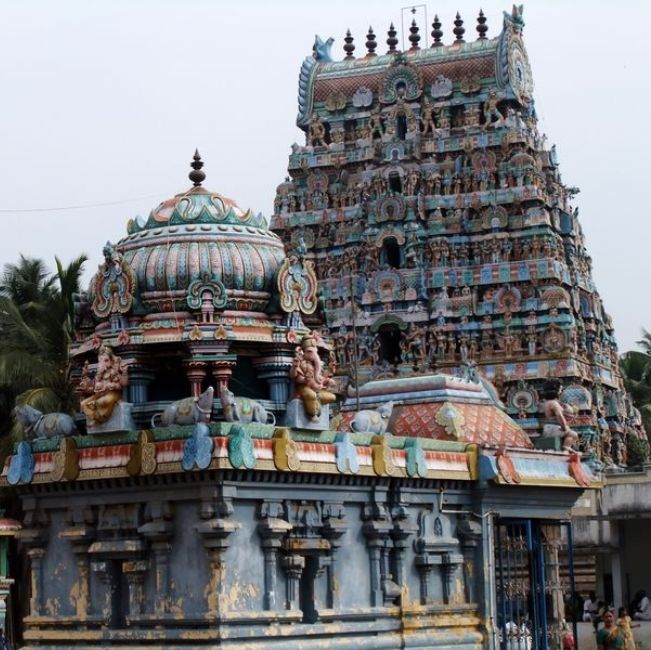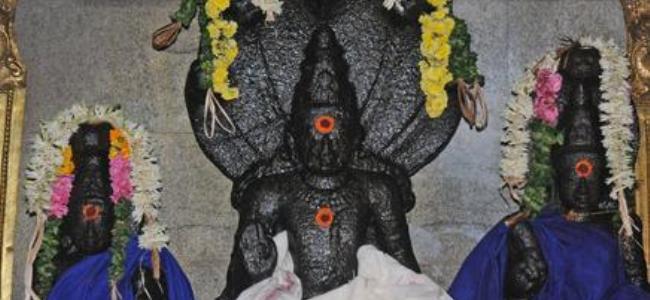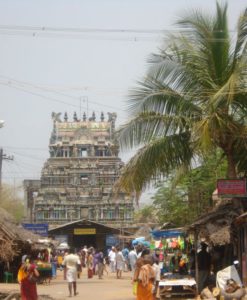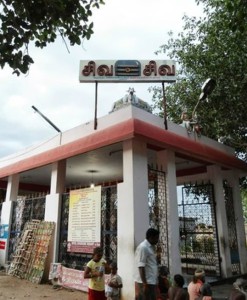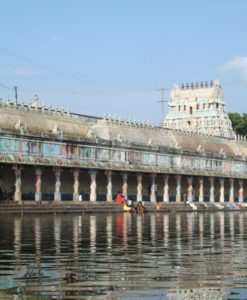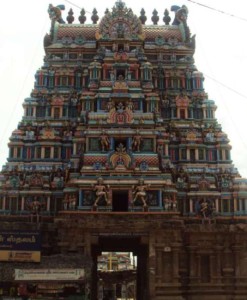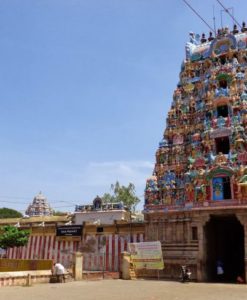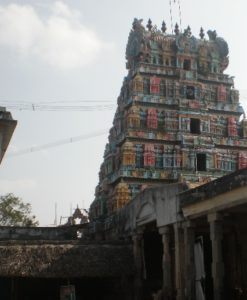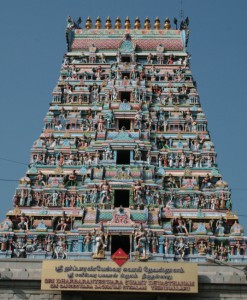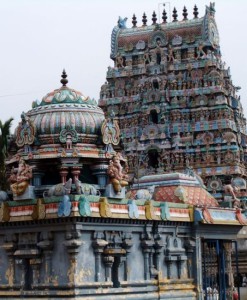No products in the cart.
Sri Naganathaswamy Temple or Rahu Sthalam is one of the 9 Navagraha temples located near Kumbakonam, Tamil Nadu and is dedicated to Rahu. It is one of the 127 temples on the southern banks of river Cauvery and also one of the Panchakrosa Sthalas.
The Presiding Deity is Lord Naganathaswamy. There are two Shrines for the Goddess; Piraiyanivanudalumai’s Shrine is adjacent to Naganathaswamy’s shrine and GiriGujambika with Lakshmi and Saraswathy by her side.
A unique feature of Sri Naganathaswamy Temple is that Rahu Bhagavan is seen with human face. Usually in other places, Rahu Bhagavan is seen with a serpent face. Here Rahu Bhagavan is present with his two consorts Nagavalli and Nagakanni. Here Lord Shiva was worshipped by Rahu and got relieved of a curse.
Another feature of this temple is that during milk abhishekam, the milk when poured over the idol, turns blue which is clearly visible.
Sri Naganathaswamy Temple,Thirunageswaram,Tamil Nadu
The sculptures and arts of the temple reminds about the architecutre of the Chola Kings and the Nayakka Kings. The temple covers an area of 630 ft (190 m) South-North and 800 ft (240 m) East-West with concentric sub lanes and four major streets around the four sides. There are four gateways along the four sides with entry towers (gopuram) and a surrounding compound wall. In the broad pathway on the third precinct, there is a flower garden on the northern side.
The Vinayaka shrine, Bali Peetam, Nandikeshwara hall and flag post are located in the eastern entrance. This Ganapathy shrine is said to have been installed by the great saint Sadasiva Brahmendra along with a Ganapathy yantra. An inscription in the temple bears testimony to this fact. The temple tank is located in the southern side and has a hundred pillared hall. The second precinct has a granite floor and enshrines the Rahu shrine in the north eastern corner. The path leading to the main shrine in the second precinct has a hall decorated with Nayak style pillars with yalis. The hall was constructed by Govinda Dikshitar, the minister of successive Nayak rulers, Achuthappa Nayak (1560–1614) and Raghunatha Nayak (1600–34). In the front hall on the eastern side, artistic pillar with “older and nine horses” design is found, while similar pillars are found on the southern side as well. There is a hall in the northern side with pillars decorated with yalis used for staging idols during the festive occasions. The renovation work in the western walls was done during 1929 with artistic inscriptions. In the path way to main shrine, there are art works depicting Veda nayakas, king Sambumali and penance pose of Ambal. The Dwarapalaga images on each side at the entrance of Naganathar shrine are made of chunam clay.
Sri Naganathaswamy Temple,Thirunageswaram campus encompasses exclusive shrines for Naganatha Swamy (Shiva), Pirayani Amman (Parvathi), Giri-Gujambika (Parvathi) and Rahu with his divine spouses. Goddess Girigujambika has a separate shrine in the north side inside the temple campus as it is believed that the goddess is in thava kolam (mode of deep penance). The entrance of the Goddess Temple is also in a tower shape.
Many serpents, including Adishesha, Takshaka and Karkotaka, worshipped Shiva at this place, leading to the name “Thirunageswaram”. As per Hindu legend, the king of snakes, Adisesha did penace at this place, called Senbaranya Kshetram on account of the presence of large number of Senbaga trees. Shiva was pleased by the penance and appeared to him. Since Shiva gave a boon to the king of Serpents, he is called Naganathar. A Goddess Girigujambika is believed to be worshipping Shiva here with goddesses Lakshmi, Saraswathi, Ganesha, Muruga, and Shasta. Maha Bhairava is still believed to be guarding and assisting the divine mother during her prayers.
As per a Hindu legend, Indra was cursed by sage Gautama as he misbehaved with the latter’s wife Ahalya. To obtain deliverance from the sage’s curse, it is said that Indra worshipped GiriGujambika with a scented material termed Punugu for 45 days. Sages like Gautama and Parashara and kings like Bhagiratha and Nalan are said to have worshipped Naganathar at this place.
The temple rituals are performed six times a day;
Ushakkala Pooja (6 am),
Kalasandhi Pooja (9 am),
Uchikkala Pooja (1 pm),
Sayaratchai Pooja (5 pm),
Irandam Kala Pooja (7 pm) and
Arthajama Pooja (9 pm)
There is a separate calendar for the Rahu Abhishekam (sacred ablution): it is performed twice in a day at 11:30 a.m and 5:30 p.m. and additionally twice at various times in the day. Each ritual comprises four steps: abhisheka (sacred bath), alangaram (decoration), neivethanam (food offering) and deepa aradanai (waving of lamps) for both Annamalaiyar and Unnamulai Amman.
The worship is held amidst music with nagaswaram (pipe instrument) and tavil (percussion instrument), religious instructions in the Vedas (sacred text) read by priests and prostration by worshippers in front of the temple mast. There are weekly rituals like somavaram and sukravaram, fortnightly rituals like pradosham and monthly festivals like amavasai (new moon day), kiruthigai, pournami (full moon day) and sathurthi.
Like other Shiva temples of Tamil Nadu, the priests belong to the Shaivaite community, a Brahmin sub-caste.
The Brahmotsvam or prime festival is celebrated for ten days in the Tamil month of Karthigai (November–December).
Kandasashti festival is celebrated for six during October or November every year when Murugan, the son of Shiva, symbolically kills the demon Surapadma. The scene is enacted in the South street of the temple during the festival. As per local legend, Rahu got relieved of his pains praying to Naganathar during a Shivaratri day and the day is celebrated in the temple. Navarathri festival is celebrated for nine days for Girigujambigai and the images of Naganathar and Girigujambigai is taken in horse chariot on Vijayadasami, the concluding day of the festival. Sekkizhar Vaikasi Pooja is celebrated from 1969 on the birth date of Sekkizhar, the author of Periya Puranam, the epic describing the life history of the 63 nayanars. Rahu Peyarchi is a festival celebrated once every 1.5 years on the star when Rahu switches its planetary position from one Zodiac to the other.
According to the story, when amirtham emerged after churning of the Paarkadal by the devas and the asuras, Lord Vishnu in the guise of Mohini was distributing the amirtham only to the devas. Realising this, Rahu (an asura) with the help of Sukrachariyar, took the form of a deva and consumed the nectar. Suryan and Chandran who noticed this, complained to Lord Narayana. In anger, Lord Narayana hit Rahu on the head with the spoon in his hand. The head was cut off and fell on the ground. But because he had consumed amirtham, his head and body continued to live. The body of the snake got attached to the head. Rahu takes his revenge on Suryan and Chandran, whenever he gets a chance by devouring them. This is commonly called as eclipse. Rahu prayed to Lord Vishnu (Narayana) and got the position of a Sayagraham.
Astrologers suggest that doing Milk abisekam (especially on Sundays) here for Rahu during Rahu kalam (period of 1and 1/2 hours occurring every day ) the malefic effects of Rahu like marriage obstacles, lack of progeny, troubled marital life, Kalasarpa Dhosham, Kalasthra Dhosha , Sarpa Dhosha are all neutralized.
Rahu is the source of plenty. He faces the South-West direction. The Adi Devatha is Durga and the Prathyathi Devatha is the snake. His colour is black, his vahana is blue lion; the grain associated with him is orid; the flower-mandarai; fabric-black cloth; gem- Komedagam; food-rice mixed with orid dhal powder.
How to Reach
By Train
Nearest Railway Stations – Tiruvidaimarudhur (5 km) and Kumbakonam Railway station (8km)
By Road
Buses Available from Kumbakonam (8km) , 10mins of travel form Kumbakona, from Tanjore and major towns such as Trichy, Madurai.
By Air
Nearest airport is Trichirapalli

